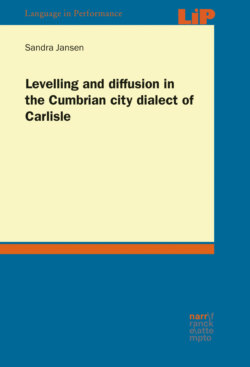Levelling and diffusion in the Cumbrian city dialect of Carlisle

Реклама. ООО «ЛитРес», ИНН: 7719571260.
Оглавление
Sandra Jansen. Levelling and diffusion in the Cumbrian city dialect of Carlisle
Inhalt
1 Introduction
2 Theoretical framework
2.1 Dialect contact
2.1.1 Accommodation
2.1.2 Levelling
2.1.3 Geographical diffusion
2.2 Regional identity
2.3 Dialects in contact: The Carlisle setting
3 Carlisle and its geographic, historic and sociolinguistic background
3.1 Geography
3.2 Demographics
3.3 History
3.4 Carlisle in the northern English context
4 Methodology
4.1 Age as external factor
4.2 Sex as external factor
4.3 Social class as external factor
4.4 Sampling methods and contacting speakers
4.5 Final sample
4.6 Interviews
4.6.1 Interview procedure and oberserver’s paradox
4.6.2 Style
5 Sociolinguistic variables
5.1 GOOSE, GOAT and FOOT
5.1.1 GOOSE, GOAT and FOOT realisation in England
5.1.2 Data analysis
5.1.3 Normalisation
5.1.4 Classification of fronting
5.1.5 Statistical modelling
5.1.6 Results. 5.1.6.1 Overall profile of the data for GOOSE
5.1.6.2 Social factors
5.1.6.3 Linguistic factors
5.1.6.4 Results for GOAT
5.1.6.5 Results for FOOT
5.1.6.6 Summary GOOSE – GOAT – FOOT
5.1.7 Discussion
5.1.8 Conclusion
5.2 (T)
5.2.1 Historical and geographical background
5.2.2 (T) in Britain
5.2.3 Data analysis
5.2.4 Statistical modelling
5.2.5 Results
5.2.5.1 Social factors
5.2.5.2 Linguistic factors
5.2.6 Discussion
5.2.7 Conclusion
5.3 (R)
5.3.1 Historical and geographical background
5.3.2 Data analysis
5.3.3 Statistical modelling
5.3.4 Results
5.3.4.1 Social factors
5.3.4.2 Linguistic factors
5.3.5 Discussion
5.3.6 Conclusion
5.4 (TH)
5.4.1 Historical and geographical background
5.4.2 Phonetic details
5.4.3 Data analysis
5.4.4 Statistical modelling
5.4.5 Results
5.4.5.1 Social factors
5.4.5.2 Linguistic factors
5.4.6 Discussion
5.4.7 Conclusion
6 Discussion
7 Conclusion
References
Acknowledgements
Fußnoten. 2.1 Dialect contact
2.1.1 Accommodation
2.1.2 Levelling
2.1.3 Geographical diffusion
4.3 Social class as external factor
4.4 Sampling methods and contacting speakers
4.5 Final sample
4.6 Interviews
4.6.1 Interview procedure and oberserver’s paradox
5.1.1 GOOSE, GOAT and FOOT realisation in England
5.1.2 Data analysis
5.1.4 Classification of fronting
5.1.7 Discussion
5.2 (T)
5.2.1 Historical and geographical background
5.2.5 Results
5.2.5.1 Social factors
5.2.6 Discussion
5.2.7 Conclusion
5.3.1 Historical and geographical background
5.3.4 Results
5.4.1 Historical and geographical background
5.4.3 Data analysis
5.4.5.2 Linguistic factors
6 Discussion
Отрывок из книги
Sandra Jansen
Levelling and diffusion in the Cumbrian city dialect of Carlisle
.....
Another geolinguistic process that recently has attracted a lot of attention from scholars is geographical diffusion. In recent years, many studies in the dialect contact framework have been dealing with geographical diffusion of linguistic features. Boberg (2000: 1) describes geolinguistic diffusion as “the process by which linguistic changes spread geographically from one dialect or language to another” while Kerswill (2003: 223), defines it as “features [that] spread out from a populous and economically and culturally dominant centre” which entails a hierarchy. In particular consonants in British English are “torchbearers of geographical diffusion” (Kerswill 2003: 231), i.e. mainly consonants are diffusing across the country in a fast manner.
The diffusion of features is enhanced by loose social networks when a change progresses through a community. Mobility is the main reason for close-knit networks to break up into loose social networks. Close-knit networks are more traditional in their language choice than loose networks which often are the engines of diffusion. Individuals in loose networks are in contact with many people often on an infrequent basis, and often from outside a community which leads to various dialect contact situations. Therefore, they are usually the ones who adopt changes easier and faster than people in a closed circle of friends and family who are usually restricted in their contacts to small areas (cf. Milroy 1987: 202-203, 213).
.....